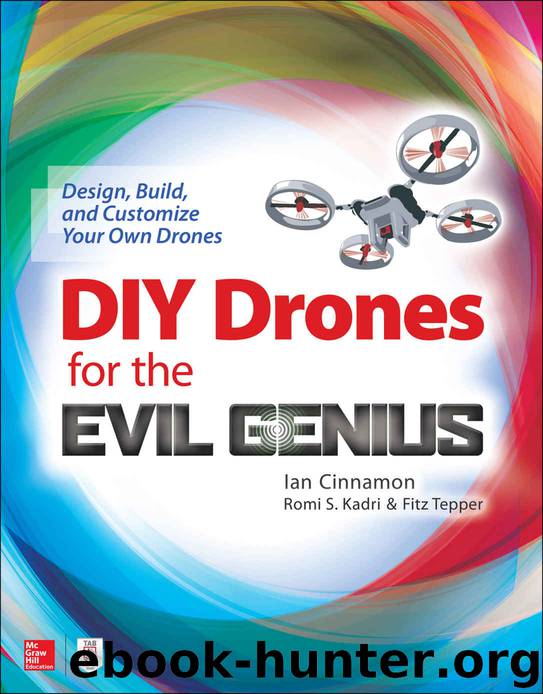DIY Drones for the Evil Genius: Design, Build, and Customize Your Own Drones: Design, Build, and Customize Your Own Drones by Cinnamon Ian & Kadri Romi & Tepper Fitz

Author:Cinnamon, Ian & Kadri, Romi & Tepper, Fitz [Cinnamon, Ian]
Language: eng
Format: epub
Publisher: McGraw-Hill Education
Published: 2016-12-01T16:00:00+00:00
SECTION THREE
Picking the Parts
Now that you know how to fly, you can start building. Using the skills from the previous two sections, you’ll put your new aerospace engineering skills to use and pick the perfect parts for your own high-performance drone.
* * *
PROJECT 11
How Big?
When building your drone, choosing an appropriate size will be your most important decision. First, you’ll explore multiple frame sizes .
* * *
Finally, the moment you’ve been waiting for is finally here: you can start building your first drone! Before starting any drone-build, you should think about the use case of the drone. Do you want a high-speed racer? A versatile drone for carrying around payloads? A cinematic rig? You’re limited only by your imagination.
In this section, you’ll build a midsized versatile quadcopter (four arms) capable of carrying a variety of payloads. The build process and techniques you use in the following sections apply to drones of all sizes. As you take an in-depth look at part selection in the next set of projects, you’ll learn how to adjust for a larger or smaller drone. Overall, everything is pretty much the same—the biggest difference will be in frame size, propeller size, and battery size.
In general, frames can be made out of anything. They only need to serve a single purpose: keep all of the other drone components together and withstand the forces of flight! Drones have been made out of recycled clothes hangers, PVC pipe, and more. There’s no wrong answer.
For the sake of simplicity, you can order a basic frame from a retailer like Amazon. To start, you should know the three most common frame sizes: 250, 330, and 450 mm. The 250 mm size is perfect for a lightweight racing drone. The 330 mm size is great for lifting a small payload. The 450 mm size is perfect for a versatile drone (Figure 11-1 ). These frames are well built, include mounting pads for the brushless motors, and have integrated power distribution boards (we will discuss this component in depth when we assemble the drone).
Download
DIY Drones for the Evil Genius: Design, Build, and Customize Your Own Drones: Design, Build, and Customize Your Own Drones by Cinnamon Ian & Kadri Romi & Tepper Fitz.epub
This site does not store any files on its server. We only index and link to content provided by other sites. Please contact the content providers to delete copyright contents if any and email us, we'll remove relevant links or contents immediately.
Turbulence by E. J. Noyes(7057)
Tools of Titans by Timothy Ferriss(6964)
Astrophysics for People in a Hurry by Neil DeGrasse Tyson(4627)
Room 212 by Kate Stewart(4113)
Pale Blue Dot by Carl Sagan(4017)
The David Icke Guide to the Global Conspiracy (and how to end it) by David Icke(3891)
Secrets of Antigravity Propulsion: Tesla, UFOs, and Classified Aerospace Technology by Ph.D. Paul A. Laviolette(3542)
Apollo 8 by Jeffrey Kluger(3205)
Losing the Nobel Prize by Brian Keating(3188)
A Journey Through Divination and Astronomy by Publishing Pottermore(3147)
Goodbye Paradise(2975)
COSMOS by Carl Sagan(2959)
Brief Answers to the Big Questions by Stephen Hawking(2883)
How to Read Water: Clues and Patterns from Puddles to the Sea (Natural Navigation) by Tristan Gooley(2873)
The Five People You Meet in Heaven by Mitch Albom(2849)
The Order of Time by Carlo Rovelli(2726)
How to Read Nature by Tristan Gooley(2668)
A Brief History of Time by Stephen Hawking(2480)
Aliens by Jim Al-Khalili(2387)
